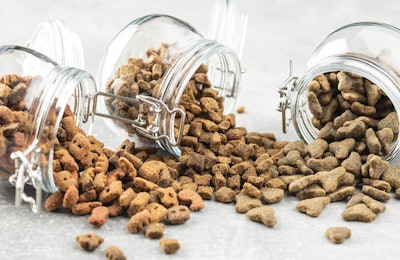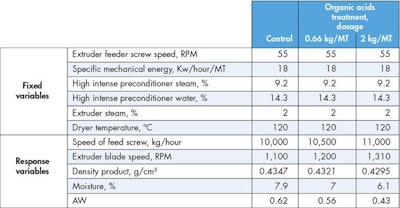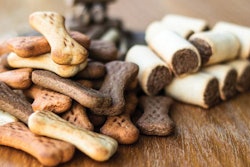
Editor’s Note: The product mentioned in this article is not available in the U.S.
To provide a complete nutritional diet to pets, each kibble undergoes extreme thermal extrusion and drying processes. Through these processes moisture from the kibble is reduced, adversely impacting its consumption preference. Simply increasing the levels of moisture can negatively impact its shelf-life stability. At the same time, increasing the drying time of the kibble limits pet food production capacity since it reduces the speed of throughput. While optimizing moisture level and production capacity without jeopardizing pet food quality can be difficult to achieve, it can yield economic benefits for producers. This article presents potential solutions for reaching this balance.
Increasing production capacity
Increasing production capacity while optimizing moisture levels in kibble can be particularly challenging. A study conducted in South America measured the effect on production parameters when adding a combination of buffered and non-buffered organic acids with surfactants in the conditioner at two different inclusion rates. Table 1 shows that applying this combination with the dryer set at 120°C resulted in a significant increase in the kilograms per hour produced while decreasing the moisture percentage and water activity (AW).

TABLE 1: Results of adding buffered and non-buffered organic acids with surfactants to the extrusion process in a pet food plant in South America.
To better understand the benefits to production efficiency, a second study was conducted. The production speed was accelerated to 11,000 kg/h, the dryer was set between 105–110 C and AW at a maximum of 0.70, as per the quality standards of the producer. Two different inclusion rates were established to compare with a control treatment. As portrayed in Table 2, the results demonstrated a maximum increase of 0.08 in AW and 2.81% in moisture. Although the AW and moisture were higher, the mold control properties of the combination of buffered and non-buffered organic acids with surfactants proved effective. The shelf life was increased by 72% when the inclusion rate was lower and by 171% when higher, in comparison to the control treatment.

TABLE 2: Results of adding buffered and non-buffered organic acids with surfactants in finished kibble.
Further studies in Latin American production facilities demonstrated that even when the dryer temperature was reduced by 14 C, the results were consistent: The moisture percentage in the kibble increased while the AW value remained below the target of 0.60 (see Table 3 and Figure 1).

TABLE 3: Results of buffered and non-buffered organic acids with surfactants applied to the extrusion process in a pet food plant in Latin America.

FIGURE 1: Evaluation of buffered and non-buffered organic acids with surfactants applied to the extrusion process in a pet food plant in Latin America.
These studies show that a blend of buffered and non-buffered organic acids together with surfactants can inhibit mold growth, increase throughput in the production process and enhance moisture in the kibble.
Controlling mold effectively and improving shelf life
Shelf life stability is particularly challenging as commercial requirements may demand up to 24 months of shelf life without a deterioration of the kibble quality. During production, large amounts of water are required. Improperly managed, this may cause an increase in AW and consequently a destabilization of the kibble in storage.
To guarantee the kibble´s shelf life, a mold inhibitor should be added. A mold inhibitor containing buffered and non-buffered organic acids with a 95% recovery of propionic acid to ensure a prolonged effect throughout its shelf life (see Figure 2) has proven to be effective even in the high temperatures reached during extrusion.

FIGURE 2: Propionic acid concentration after extrusion.
Surfactants must also be considered. Surfactants contribute positively to the homogenous distribution of both added moisture and the organic acids. During preconditioning, surfactants reduce the surface tension of water increasing the total fixed water in the kibble, which derives in a lower free water level.
Optimizing the production capacity of the pet food plant while safeguarding product quality can be challenging. Yet, applying innovative solutions can bring economic and productivity benefits. As this article demonstrates, selecting a highly concentrated blend of buffered and non-buffered organic acids with surfactants can prevent mould growth while optimizing moisture levels in kibble. As a result, production capacity can be improved without compromising pet food quality.
Read the companion article, "What does sustainability look like in pet food extrusion?,” published in the December 2020 issue of Petfood Industry magazine.
Arlette Soria is a nutritionist for South and Central America for Trouw Nutrition. Prince Nanda is the global product manager Fylax/Fysal for Trouw Nutrition.
















